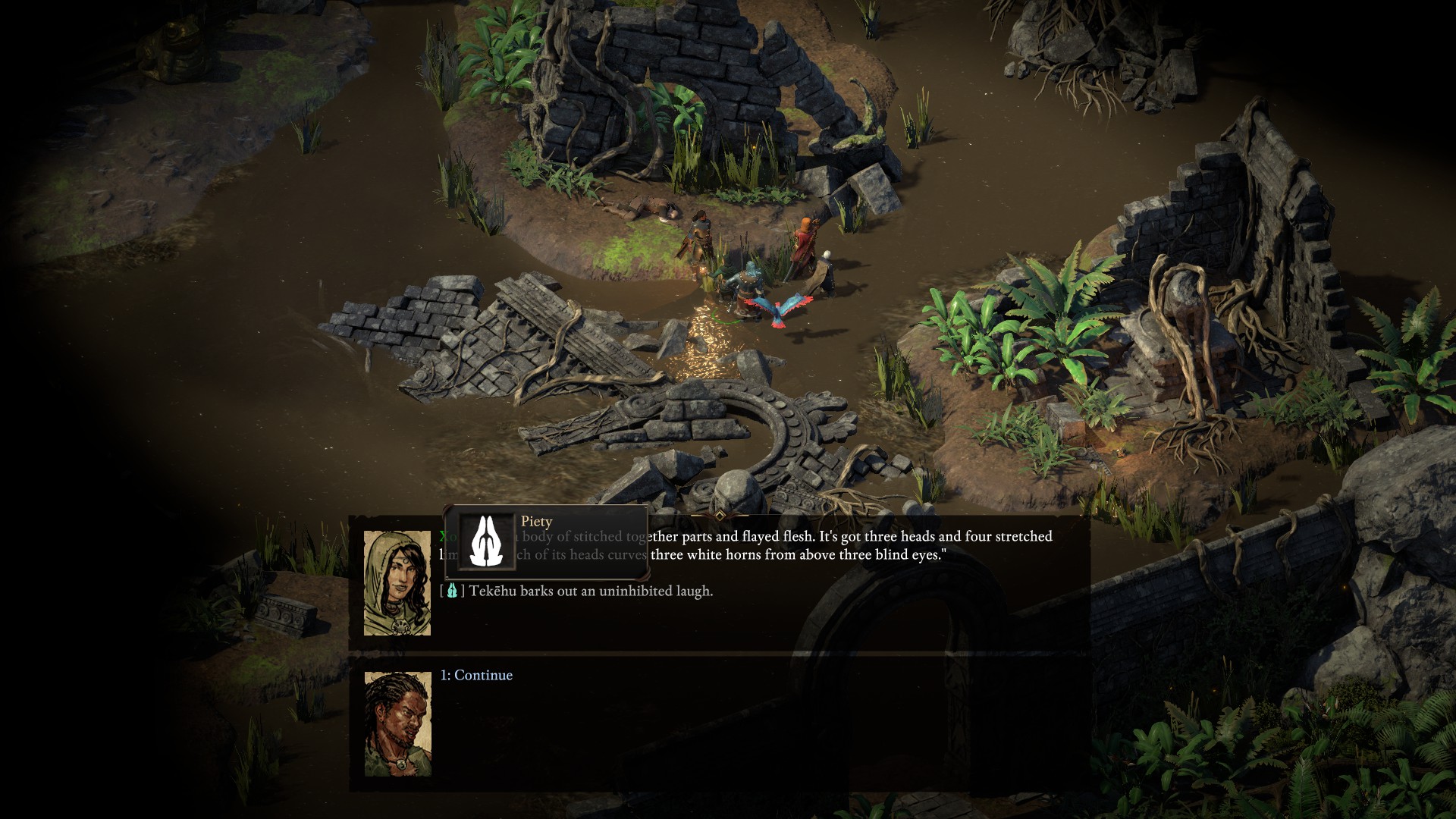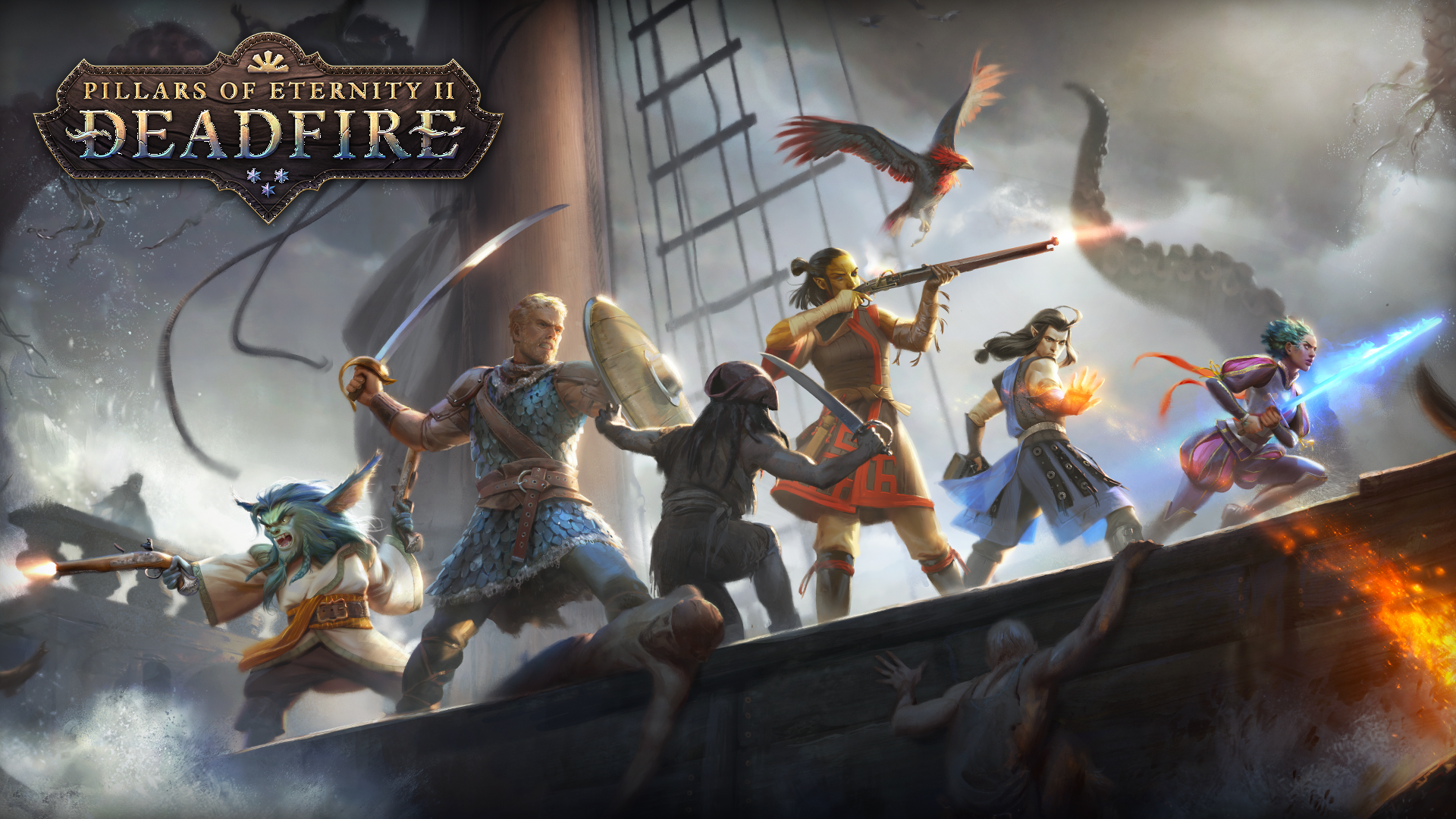Modern CRPGs quite often walk the line between “piece of gaming individual of itself” and “living monument to history.” Almost all of them take heavy inspiration from games that have come before them. Many of them bathe in this reverence to The Games That Came Before. Obsidian has made a career doing just that.
The best of these games know when to look at what is, and reinterpret and re-imagine. Things that worked 15-20 years ago just don’t anymore. Obsidian has done decent work in this area, too. In fact, the best things about Pillars of Eternity 2: Deadfire, the highly anticipated sequel to one of the most highly regarded RPGs of this era, are when it is the most different from its Infinity Engine and Tolkienesque fantasy trappings.

For the uninitiated, the original Pillars of Eternity centered around a generic protagonist called The Watcher. You’re unique ability to speak directly to souls, living and dead, played a key role in a calamity that was causing newborn babies to be born without one. The Watcher would gather a party of unlikely allies and challenge the gods themselves in order to put a stop to the crisis.
For returning players, Pillars II knows everything your Watcher did in the first game (should you provide a previous save or fill out a compulsory questionnaire). You’ll continue to answer for those choices as you land haphazardly in the Deadfire Archipelago, on the trail of a towering god who’s single-minded purpose is putting countless lives in jeopardy. The journey of following his enormous footsteps around the Deadfire is one worth remembering, if mostly because of how well realized the Deadfire is.

Fantasy settings, like CRPGs broadly tend to care more about resembling the iconic versions of it than taking elements of it and creating a new vision. Obsidian didn’t get that memo here. Inspired heavily by the Age of Sail and pirate myth, Deadfire is elves and dwarves and swords and sorcery shotgunned across Caribbean/Polynesian history and culture. The world is a much more dynamic place because of it. Even when it’s at its most tropey, Deadfire’s setting still makes things interesting.
Regional traditions are just as important as the top line racial qualitatives that often sink fantasy into a tropey quicksand. Knowing that different sorts of people may worship the same gods different ways, and that this may be something you have to leverage with diplomacy, is a great way to make every new assortment of people you meet immediately interesting, outside of just being a named NPC who clearly has a quest for you.

Deadfire sheds some of the more bland parts of the original game’s world building as well. The Dyrwood felt like any provincial pseudo-European Renaissance setting; one splashed with pointy-eared people who can sling fire with their minds. The many races of standard fantasy, including some of the ones unique to Pillars, are naked representations of different parts of Western Europe. Every place they are traditionally set in, from Middle Earth to Greyhawk, do as well. It’s a mono-cultural regurgitation-via-tradition that is great for traditionalist and Medieval Europe buffs.
Deadfire feels sci-fi in how it breaks from these fantasy bonds. There’s room for differing societies, full of people that look nothing alike, to blend and butt up against one another. The ways both the main and sub-plots explore all of these corners is compelling.
There’s also a sci-fi sense of otherworldly adventure and swashbuckling. Part of that lies in just how much science fiction stories have adapted pirate tropes over the years. Stories of ships crewed by a gaggle of folks diverse in language and molecular structure were popular long before Star Wars. Having those concepts backwash back into actual pirate tales is a welcome look. For what it’s worth, there are also way more guns in the Deadfire.

Your crew of companions help bring the various cultural threads directly to you. They are from various walks of life, and some may even be holdovers from the first Pillars, depending on your choices. They all have their own interests and motivations, many of which overlap and clash with each other and your own. Like Fallout: New Vegas and Tyranny, Obsidian created a nuanced system of quirks and reactions that keep all of your relationships natural. There are reputation-based advantages and disadvantages that are like a meter, each sliding back and forth, but it remains well hidden throughout.
Some characters are transformed in ways you wouldn’t expect by your journey, having the limits of their ethics (and yours) tested regularly by the rigors of the morally ambiguous life you live. It’s not uncommon that you’ll be saving a small village from malicious aberrations, then immediately walk into a den of ruthless pirates to organize a heist, or try to convince a spice trade banker to loosen their purse strings to feed the poor. You’re as righteous as you want to be, and you’ll attract and repel your comrades based on this flexibility. Same goes with NPCs and other organizations in the Deadfire. Nothing is cut and dry anymore, and people who look like friends could quickly become enemies, and the other way around.

Your headquarters during your adventure is your ship. As captain, you’ll be charged with hiring crew and keeping them fed and paid. Crew members fill various roles like navigation and canoneering, and have varying skills in each. Keeping the best people for each job will ensure that you’re operating efficiently. You really don’t see the full effects of a well maintained crew until you’ve had a couple sea battles.
When accosted by enemy ships, you enter a more elaborate version of your normal, text-heavy encounter screen. Instead of a blurb that describes walking through city streets or browsing through books, you get a description of you and your opponent on the high seas. It does a decent job informing you of distance, weather factors, ship facings and the like, but reading these ship battles is somewhat underwhelming when so many games nowadays have mastered making ship battles visually entertaining.

There is an ironic clarity to it though, when faced with the rigors of the normal combat system. Real Time With Pause combat is hit or miss, and of the genetic trappings of Baldur’s Gate that Pillars II strives to move away from, this should have been higher on the list. Some changes have been made, there are now five active members in a party instead of six. This change was made to make it easier to follow combat, but there’s really no good way to keep track of this kind of combat in this old form.
When battle happens, the screen pauses to let you assess your opening moves. Once it gets going, allies make choices based on an editable set of AI decisions that are supposed to tell your companions to use appropriate abilities at appropriate times. Needless to say, expecting this to happen with the out of the box settings is a fool’s gamble.

AI behavior can be modified individually to suit your needs, but the interface is somewhat of a spider web of if-then statements that don’t help you make the best choices. Letting the AI go without at least some tweaks will compel them to do strange things like attack whatever is in their sights without taking flanking or other tactical advantages into account. You can pause at anytime, and give each character a new set of orders, but this is a struggle you’ll constantly have. Keeping your companions on track can be a more ferocious affair than taking down some of the games most fearsome bounties.
There are games that do this sort of style well. Final Fantasy XII, FTL, Mini Metro, etc. all make planning a strategy and making tactical adjustments mid-action feel legible and meaningful. Much of this may be because the UI is ultimately more manageable and the feedback more direct. Pillars II, scooping all of its pen and paper baggage into this management-heavy style, might be too complex to make this work without some friction. When you turn the adjustable combat speed down, things become more manageable, but you can’t help but wonder why this couldn’t have just been turn-based the whole time.

The paperwork part of Pillars II combat—the character creation and management—is a bit too convoluted for its own good. There are plenty of options, lots of opportunity and customization for those looking for that sort of granularity. There’s also cross classing for yet another layer of party pimping. But it’s pretty overwhelming if you’re not willing to submerge yourself in it to figure out the best combinations and abilities. Especially since your AI needs to be babysat so closely.
Closing Comments
In the end, I will remember Pillars II for its expert reinvigoration of the fantasy genre as a storytelling device. The colorful places of the Deadfire are a perfect compliment to many shades of grey in its moral make up. The mechanics of playing Pillars are serviceable at best, and really have to be toyed with on an individual basis to find that workable sweet spot. It never stopped me from pushing on in pursuit of Eothas, the once dead god, but it may stop me from coming back to the game again to test out new race/class combos, or to explore the hours and hours of side stories and optional content.
Pillars of Eternity II Steam code provided by publisher for review.






